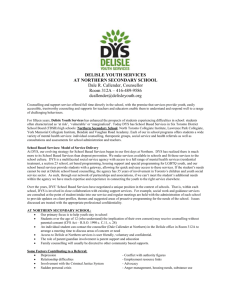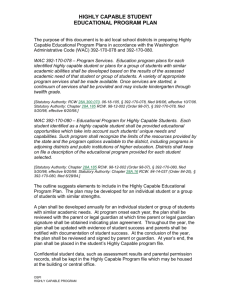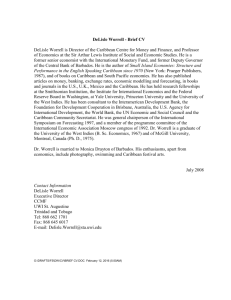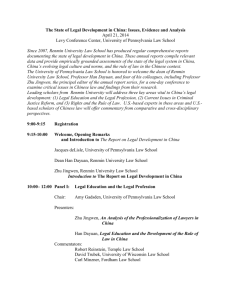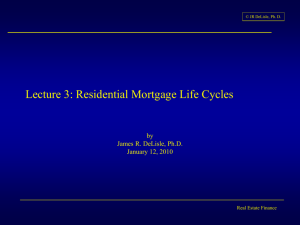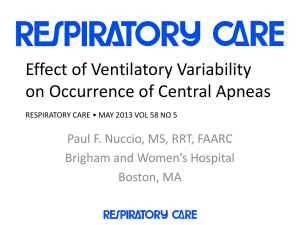What Is Sustainable Development?
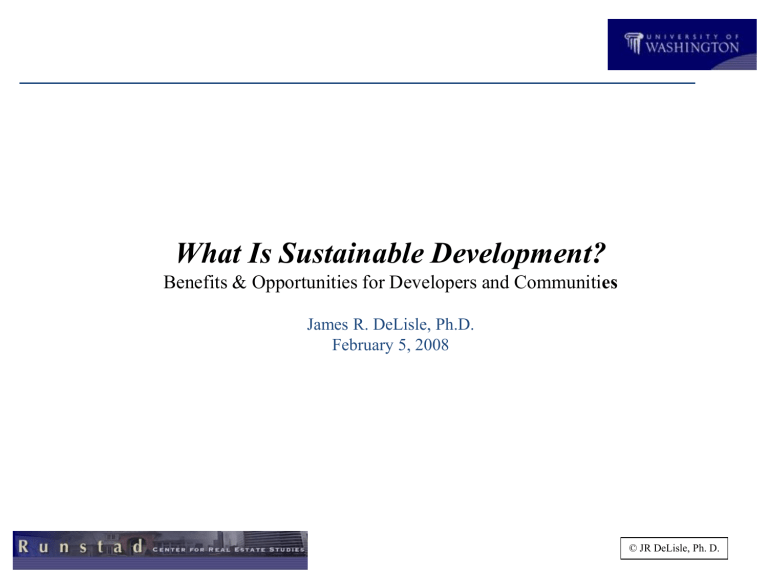
What Is Sustainable Development?
Benefits & Opportunities for Developers and Communiti es
James R. DeLisle, Ph.D.
February 5, 2008
© JR DeLisle, Ph. D.
Presentation Overview
• Sustainable Real Estate
– Value Proposition
– Most Fitting Use
– Holistic Approaches
– Alternative Metrics
• Sustainable Real Estate Movement
– Nature: Structural shift, with cyclical risks
– Need: Strong emotion, less empirical
• Issues
– Risks
– Barriers
– Opportunities
© JR DeLisle, Ph. D.
Overview
• Key Questions
– What is Sustainable Real Estate?
– What are Green Buildings?
– What, When, Where Why and How go Green?
• Our Challenges in Moving Toward Sustainabilty
– Growing right with economic, environmental, ethical and social challenges
– Responding to challenges of Global Warming and environmental degradation
– Striking balance between needs of current and future generations
– Developing customized, collaborative, inclusive values
– Ensuring effectiveness and efficiency
– Approaching the issue from a holistic perspective
© JR DeLisle, Ph. D.
Sustainable Real Estate
• Definition of Sustainable Real Estate
– The use of scarce real estate in an efficient, economic, equitable and socially responsible manner that provides an acceptable –if not optimal– fit between users of space and the space that is produced that has an existing and enduring effective demand and balances the needs of current and future generations.
• Evaluative Criteria
– Efficient, economic, equitable and socially responsible uses
– Achieves goodness-of-fit between users and space
– Satisfies current and future demand for space
– Balances needs of current and future generations
© JR DeLisle, Ph. D.
The Real Estate Sustainability
Spectrum
What are the three key dimensions of Real Estate?
S…. E…. L….
Static
Environment
Linkages
Sustainable….
© JR DeLisle, Ph. D.
How Look at Real Estate?
• Perspectives
Money
-time
Space-
• Dimensions: space-time, money-time
© JR DeLisle, Ph. D.
Highest and Best Use vs. Most Fitting
Use
• Definition
The reasonably probable and legal use of vacant land or improved property, which is physically possible, appropriately supported, financially feasible, and that results in the highest value” as of the date of the appraisal.
• Criteria
– Legal
– Physically possible
– Reasonably probable
– Financially feasible
– Maximize value
• Most Fitting Use
– “Satisficing or Optimizing” vs. Maximizing Value
© JR DeLisle, Ph. D.
Interdisciplinary Approach to
Sustainability
Disposition/
Redevelop
Operation
Planning
Acquisition
/Production
$
Feasibility
Marketability
Appraisal
Engineering
Architectural
Environmental
Legal
Cost Estimation
Negotiations
Construction Mgmt.
Quality Controls
Project Mgmt.
Architectural Oversight
Cost Mgmt.
Construction Financing
Inspections
Pre-leasing
Releases
Final Inspection or
Sourcing if Existing
Portfolio Mgmt.
Asset Mgmt.
Leasing
Tenant Improvements
Tenant Relations
Property Mgmt.
Accounting/Reporting
Engineering
Financial Mgmt.
Time
Hold/Sell Analysis
Marketing
Valuation
Buyer Selection
Broker Management
Negotiations
Closing
© JR DeLisle, Ph. D.
Real Estate Valuation Model
Value
Value = Income/Return
* Return
Return = Income/Value
Income = Value * Return
Income
Cost
© JR DeLisle, Ph. D.
Frontdoor Model Toward
Sustainable Real Estate
TRCm
* Wcc
NIr / NIR
Land
Hard & Soft Costs
TRCm
GIr
© JR DeLisle, Ph. D.
Backdoor Model Toward
Sustainable Real Estate
Market
TRCj
* Wcc
NIm
RCR
GIm
/ NIR
Land
Hard & Soft Costs
TRCj
© JR DeLisle, Ph. D.
Green Building and Project Finance
Financing
D/E
Site
Selection
* Wcc
Risk/Return
Hurdle
NIr / NIR
Operating
Efficiency
GIr
Lease
Structure:
Who
Captures?
Materials
& Labor
TRCm
© JR DeLisle, Ph. D.
Sustainable Real Estate Value
• Value:
– cost of materials
– costs of construction
– cost of financing
– cost of fees
• Income
– gross income
– net level, pattern
• Return
– absolute vs. risk-adjusted
– attribution to income vs. value
© JR DeLisle, Ph. D.
TRCj
Improvement
Cost
Land Value
Sustainability: Irretrievable
Commitments
TRCje
Improvement
Cost
Demolition & Lost Income
Wcc
NOIe
Wcc
* Wcc
NOIn
NOI gap
© JR DeLisle, Ph. D.
Sustainable Business Models
• Function: ( Quantity of Business + Cost of
Business + Quality of Business + Continuity of
Life)
(NOI)
(NOI)
(NOI)
(NOI)
(NOI)
© JR DeLisle, Ph. D.
Green: What it is & What’s Driving It?
• Background
– Historical
• Cyclical phenomenon tied to energy costs
• Lessons Learned
– Recent
• Global Warming Catalyst tied to environment
• Social Responsibility
• Urban Environmental Issues
– Energy Depletion
– Greenhouse Gases
– Climate change
– Stormwater Control
– Urban Heat Island Effect
– Transportation: Congestion and Pollution
© JR DeLisle, Ph. D.
Green: Where’s it Going?
• The Green movement is a Temporary
Phenomenon…
6 0 %
50 %
• 500 + Corporate & Institutional Investors
4 0 %
3 0 %
2 0 %
10 %
0 %
St ro ng ly
Ag ree
Ag ree
• Major Interest Groups/Catalysts
– US Green Building Council (USGBC)
– Mayors 2030 Challenge
– CSR: Corporate Social Responsibility
– SRI: Socially Responsible Investing
– RPI: Responsible Property Investing
– Green Finance Consortium
– Property Insurance
Neit her Dis ag ree St o ng ly
Dis ag ree
Corporate RE Executives
© JR DeLisle, Ph. D.
Green Buildings: Diffusion of
Innovation
Global
Warming
Corporate
Social
Responsibility
Innovation Growth Maturity
Rising
Energy
Costs
Profit/Return
Rising
Requirements
Growth in
Membership in USGBC
7000
6000
5000
4000
Decline
3000
2000
1000
0
95 96 97 98 99 2000 1 2 3 4
© JR DeLisle, Ph. D.
5
Green Communities: Competitive
Positioning?
http://www.sustainlane.com/us-city-rankings/seattle.jsp
© JR DeLisle, Ph. D.
Other Drivers toward Sustainability
• Corporate Social Responsibility
• Socially Responsible Investing
• Green Building Finance Consortium
• Graaskamp on Social Responsibility: he goes and real estate is the business of building that terrarium. So we have a tremendous ethical content, tremendous social purpose. The student is looking for a field in which entrepreneurship and a way of life can be integrated into social purpose. We like to argue that the entrepreneurship of tomorrow is going to be the individual who can inventively implement social policy.
© JR DeLisle, Ph. D.
Corporate Real Estate: Value Creation
Maximize
Optimize
Enhancing
Enduring
Minimize
Situational
Tactical
Perspective
Strategic
© JR DeLisle, Ph. D.
Why are companies Going Green
Corporate Business Model
Gross Revenues
Costs of Goods
Labor
Real Estate Costs
Time
Corporate Social Responsibility
Profit
Profit
© JR DeLisle, Ph. D.
Green Cost Savings
• Green Cost Savings
19%
26%
3%
6%
Energy =
0%
30%
6%
3%
1%
4%
4%
28%
• Context
– Energy = 30% of operating costs
– Operating costs = 39% of real estate costs
– Real estate costs = 10-15% of business costs
– 20% energy savings = .2-.6% of business costs
Electricity
Oil
Gas
Water
Sewer
External Building
Interior Systems
Roads & Grounds
Utility & Central Systems
Treatment & Envronmental Systems
Janitorial
© JR DeLisle, Ph. D.
How Green? LEED Certification
• LEED: What it is?
– Leadership in Energy and Environmental Design (LEED) Green
Building Rating System™
– Benchmark for the design, construction, and operation of high performance green buildings
• LEED Categories
– LEED CI: Commercial Interiors
– LEED CS: Core & Shell
– LEED EB: Existing Buildings
– LEED NC: New Construction
© JR DeLisle, Ph. D.
LEED New Construction
– Exceptional Performance in Achieved LEED-NC Credit
– Innovation in other Green Building Categories • Innovation in Design 5
• Sustainable Sites 14
–
Reuse existing building/sites
– Protect natural and agricultural area
–
Reduce need for automobile use
–
Protect and/or restore natural sites
–
Develop only appropriate sites
• Materials & Resources 13
• Energy & Atmosphere 17
–
Use materials with less environmental impact
– Reduce & manage waste
–
Reduce amount of materials needed
–
Establish energy efficiency and system performance
–
Optimize energy efficiency
–
Encourage renewables and alternative energy sources
–
Support ozone protection protocols
• Water efficiency 5
• Indoor
Environmental Quality 15
–
Reduce quantity of water needed for building
–
Reduce municipal water supply and treatment burden
–
Establish good air quality
–
Eliminate, reduce and manage the resources of indoor air pollution
–
Ensure thermal comfort and systems controllability
–
Provide for occupant connection to the outdoor environment
© JR DeLisle, Ph. D.
Geddes, EDA W NV
Other Approaches to
Sustainability
• ABGR: Australian Building Greenhouse Rating, AUS 2005
• BASIX: Building Sustainability Index, NSW 2004
• BEPAC: Building Environmental Performance Assessment Criteria, Canada 1993
• BREEAM: Building Research Establishment Environmental Assessment Method, UK 1990
• CASBEE: Comprehensive Assessment System for Building Environmental Efficiency, Japan
2004
• CEPAS: Comprehensive Environmental Performance Assessment Scheme, HK 2001
• EMGB: Evaluation Manual for Green Buildings: Taiwan 1998
• Energy Star: USEPA & DOE Rating on Energy Efficiency & Indoor Env.
• EPGB: Environmental Performance Guide for Building, NSW
• GHEM: Green Home Evaluation Manual, China 2001
• GreenStar: Green Building Council, AUS
• HKBEAM: Hong Kong Building Environmental Assessment Method, HK 1996
• NABERS: National Australian Building Environmental Rating System, AUS 2001
• SBAT: Sustainable Building Assessment Tool: South Africa
© JR DeLisle, Ph. D.
Ding, Grace 2007
Primary Research: LEED Market
Penetration
© JR DeLisle, Ph. D.
LEED Platinum: New Construction
Example
Total
Number
= 35
© JR DeLisle, Ph. D.
Market Share by Type by LEED Rating
Type
Commercial Interiors
Core and Shell
Existing Building
New Construction
Total Number
Platinum Gold
19% 14%
6%
19%
56%
100%
6%
9%
71%
100%
36 208
Silver Bronze Total
18% 0% 16%
5%
5%
73%
100%
0%
0%
100%
100%
5%
8%
71%
100%
211 3
Total
74
24
35
325
458
© JR DeLisle, Ph. D.
Existing Building : Share with
Sustainable Sites
Sustainable Sites
Site Selection
Green Site Plan
Green Site - Chemicals
Vegetated Ground Cover
Native or Adapted Vegetation
Bicycle Friendly
Public Transportation Access
Parking Capacity
Urban Redevelopment
Non-Roof
Light Pollution Reduction
Alternative Fuel Refueling Stations
25% Runoff Reduction
Treatment
Heat Island Reduction, Roof
Efficiency
Efficiency
10% Water Use Reduction
50% Water Efficient Landscaping
20% Water Use Reduction
No Potable/Irrigation Landscaping
Innovative Wastewater Tech
Points/Category
Energy & Atmosphere
Quality
100%
83%
83%
78%
78%
72%
61%
56%
50%
94%
78%
72%
44%
22%
50%
50%
44%
44%
Energy & Atmosphere
Maintenance Contracts
Compr. Pre.Maint.Program
Additional Ozone Depletion
Optimize Energy Performance
Measurement & Verification 1
Continuous Commissioning
Measurement & Verification 2
Emission Reduction Reporting
Green Power
Measurement & Verification 3
Renewable Energy
Continued Existing Building Use
Construction Waste Manage.
Occupant Recycling
Recycled Content
Certified Wood
Resource Reuse
Local/Regional Materials
Rapidly Renewable Materials
94%
83%
78%
72%
67%
61%
61%
33%
100%
100%
72%
56%
56%
50%
44%
33%
28%
17%
11%
33%
6%
Materials & Resources
Materials & Resources
Indoor Enviromental Quality
Green Entryway Systems
Green Pest Management\
Green Disposable Products
Construction IAQ Plan
Green Cleaning and Housekeeping
Green Mixing Areas
40% Views
ASHRAE 62-1999
Outdoor Chemical Storage
Compliance with ASHRAE 55-1992
Thermal Comfort Monitoring
CO2 Monitoring
Green High Volume Copying
80% Views
65% Daylight
Increase Ventilation
45% Controllability
90% Controllability
67%
61%
61%
56%
50%
50%
50%
50%
94%
94%
82%
78%
78%
67%
67%
11%
6%
6%
Innovation & Design Process
Innovation & Design Process
Accredited Professionals
Sustainability Education
Innovation 1
Innovation 2
Innovation 3
100%
94%
72%
50%
28%
© JR DeLisle, Ph. D.
Distribution of LEED
Certification by Level
LEED
Share:
Rating by Type
80
60
40
20
0
180
160
140
120
100
Platinum Gold Silver Bronze
Commercial Interiors
Core and Shell
Existing Building
New Construction
© JR DeLisle, Ph. D.
Geographic Dispersion by Type of Green Activity
© JR DeLisle, Ph. D.
Sustainable Building Assessment
Tool (SBAT-1)
Gibberd, J 2003
© JR DeLisle, Ph. D.
Responsible Property Investing (RPI)
• Overview
– Nature: going beyond compliance with minimum legal requirements
– Goal: better manage the risks and opportunities associated with environmental, social, and governance issues in property investing.
– Rationale: reduce risk and pursue opportunities while addressing the challenging issues facing present and future generations.
• Scope
– A variety of efforts to address ecological integrity, community development, and human fulfillment in the course of profitable real estate investing.
– Level: Portfolio, asset, or property management
© JR DeLisle, Ph. D.
Drivers and Barriers to RPI
Drivers Behind RPI
Barriers to RPI
Concern for risk and return
Opportunities to outperform
Business advantage
Moral responsibility
Voluntary codes of behavior
Internal leadership
Cost avoidance
Customers
Employee recruitment/retention 3.2
Investors 3.1
Peer activity
Stakeholder pressure
2.8
2.7
4.6
4.3
4.2
4.1
3.9
3.9
3.9
3.7
Insufficient financial performance 3.9
Insufficient tenant demand
Lack of products to invest in
3.7
3.4
Lack of information 3.3
Incompatible with fiduciary duty 3.2
Legal Restrictions
Internal resistance
2.7
2.4
Source: RESPONSIBLE
PROPERTY INVESTING:
A Survey of American Executives
Gary Pivo, 2007
© JR DeLisle, Ph. D.
Green Building Finance Consortium
Collaborating Groups
Founding Members
– National Association of Realtors
– BOMA International
– CB Richard Ellis
– City of Seattle
– Kennedy Associates Real Estate
Counsel
– Cherokee Investment Partners
– Swinerton Builders, Inc.
– Davis Langdon
– EPA EnergyStar Division
– Northwest Energy Efficiency Alliance
– Revival Partners
– The Appraisal Institute
– Royal Institute of Chartered Surveyors
– CoreNet Global
– American Institute of Architects
– World Business Council for Sustainable
Development
– Commission for Environmental Cooperation
– Vancouver Valuation Accord
– U.S. Green Building Council
– High Performance Building Protocol
Committee
– Lawrence Berkeley National Laboratories
– ASHRAE 189P High Performance Building
Standards
© JR DeLisle, Ph. D.
GBFC Mission/Challenge
– Structure
• Independent organization
• Collaborative Approach
– Mission/Challenge
• Enable Private Sector Investment
• Appropriate recognition of the “value” of Green Building
Investment
• Development of Property Specific Process
• Focus on risk assessment – downside and upside
• Greater emphasis on existing buildings
© JR DeLisle, Ph. D.
Underwriting Sustainable Buildings:
GBFC
• Underwriting Question
Are the benefits of investment sufficient to compensate for the risks undertaken?”
• Standard
– Fiduciary purpose, not tactical or strategic
– Independent (3 rd party) testing of investment assumptions
• Approach
– Value is incorporated, but the focus is risk
– Underwrite to specific investment criteria
• Return Hurdles
• Risk Tolerances
© JR DeLisle, Ph. D.
Institutional Investors vs. Corp. on Statements on Green
NCREIF Respondents All Respondents
Developers must be forced to go green
Bottom line precludes green buildings
Research justifying green is sufficient
Market will go green on its own
Tenants willing to pay for green
Indoor environments are important
Gov can do more to promote green
My organization prefers LEED buildings
Green buildings reduce greenhouse gases
Green is temporary
1.0
2.0
3.0
4.0
Strongly Agree Strongly Disagree
5.0
© JR DeLisle, Ph. D.
Investors & Corp Respondents:
Green Decisions
NCREIF Respondents All Respondents
Once green, easy to maintain
Green in 3rd party contracts
Green should be part of CSR
Need incentives for existing buildings
Decisions consider Econ & Non-econ
Green is continuum not Y/N
KPIs must reflect green
LEEDs will be standard
Easy to quantiy "greeness"
Green approaches are too fragmented
1.0
2.0
3.0
4.0
Strongly Agree Strongly Disagree
5.0
© JR DeLisle, Ph. D.
Biggest Barriers: Corp vs. Inst.
• Efficacy and Cost-effectiveness
– The party paying not one benefiting
Investors
Institutional Investors
– Building payback is short-term
• Costs, costs
– Office space is a commodity product
• Perception of higher costs
– Hold periods too short to justify • Must be financially feasible
• Knowledge
– Too many unknowns
– Lack of long term benchmarking
– Lack of demand by clients/tenants
– Lack of research & public education
• Knowledge of benefits to various parties
• Lack of knowledge
• Commitment
– Retrofitting existing isn’t justified
– Tenants don't know or care
– When tenants decide, developers will follow
• Education
– Requires new methods/education
– Educating the public on the pros and cons
– Cost/benefit analysis
• Lack of incentives
• Investor buy-in
• Investor interest
• Costs then education
• Education of public
© JR DeLisle, Ph. D.
Greatest Opportunities: Corp vs. Inst.
• Education
– Consistent, fact based, education
Investor
Institutional Investors
• Image
– Education of managers & investors
• Self-sustaining, renewable energy
– Identifying "low hanging fruit"
• Competitive Advantage
– First mover advantage
– Better work environment; productivity
– Marketing as customers demand green
• Spatial Impacts
– Improved performance and operations
– More comfortable building & operation
• Good PR, leadership
• Marketing, Market Advantage
• Good public policy
• Lower operating costs
• Cost savings
• Increased productivity
• Environmental Benefits
– Sustainability & ecology effects
– Reduce resources; energy savings
– Carbon reduction, waste reduction
• Actually improve air
• Doing the right thing
• Environmental benefits
• Reduce carbon
© JR DeLisle, Ph. D.
Research Issues: Corporate vs. Inst.
• Performance
Investors
NCREIF
– How measure benefits?
– Do studies show operational savings?
– Factual data on effects, net costs
– What added costs, new and existing
• What is real benefit?
• How much does it really cost?
• What is payback period?
• Lessons Learned
• Benchmarking; how measure?
•
– What mistakes have you seen
– Keep open mind and not one answer for all
–
• What interests of clients?
• How be cost competitive?
• How improve social benefits?
Education
– • What are clients interests?
– Beyond materials & energy, what works?
• Who is going to lead?
– Does green give competitive advantage?
• How quantify and justify?
• Approaches
– Beyond LEEDS; RPI & energy star?
• What trade-offs
– How create more incentives?
• How affect value?
© JR DeLisle, Ph. D.
Biggest Risks: Corporate vs. Inst.
• Complexity
– Too complicated, too fast
– Continuing to ignore existing buildings
• Efficacy
Investor
– Projected savings not recaptured
– Higher costs more to maintain in long run
– Tenants or users don't like the product
– Too much hype, too fast; bogus case studies
• Uncertainty
– Not knowing what the economic effect is
– Unproven technologies that don’t work
– Unexpected side effects, such as air quality
• Market Acceptance
– Not Getting public buy-in/losing support
– Developers spend & tenants don’t respond
• Interventions Institutionalized
– Being forced with unintended consequences
– Movement entrenched in building codes
Institutional Investor
• Too much, too soon
• Not catch on; too complex
• Failure of untried products
• Negative performance impacts
• Surge in new construction
• Discussion out of hand
• Too much, too soon
• New technology
• Lack of tenant interest
• Temporary phenomenon
• Excessive gov interventions
• Too knee-jerk, high-handed
© JR DeLisle, Ph. D.
Summary
• Sustainable Real Estate Movement
– Nature: Structural shift, with cyclical risks
– Need: Strong emotion, less empirical
• Sustainable Real Estate
– Value Proposition
– Most Fitting Use
– Holistic Approaches
– Alternative Metrics
• Issues
– Risks
– Barriers
– Opportunities
© JR DeLisle, Ph. D.
